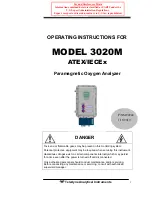
AP301-FULL-HD_rev.09_UK
5
1.2.
GENERAL WARNINGS
•
The liquid of the monitor is harmful. If the module breaks and the liquid eventually
comes out, do not touch with your hands or any part of your body, especially eyes and
mouth. In any case, wash immediately with water and soap.
•
Do not expose the LCD to direct sunlight or to intense ultraviolet rays for a long time. It
might deteriorate.
•
Keep the instrument in a place where the temperature is higher than the minimum
storage temperature, otherwise the liquid inside the crystal solidifies and causes damage
to the monitor. Where temperatures are higher than the maximum storage temperature,
as well, the liquid inside the crystal returns to the isotropic state and the process could
be non-reversible.
•
One of the most common causes of demand for technical support are internal short-
circuits, due to even tiny outer bodies which may enter the instrument, despite all
precautions to avoid it. Therefore it is strongly recommended not to cut coaxial cables
near the instrument, since even very small pieces of wire from the shielding braid could
fall into the instrument and thus provoke occasional short-circuits, not easily-detectable
by technicians.
1.3.
MAINTENANCE
Permitted interventions are only: connection or replacement of the battery and/or fuses,
and insertion of internal accessories as specified in the manual.
The opening of the instrument and possible servicing must be carried out only by qualified
personnel or by operators with basic electrotechnical and electrical safety knowledge.
•
Disconnect the power-supply cable before servicing.
•
For instruments with battery, please refer to paragraph 1.1.
•
Replace fuses with specified value and type.
•
Do not come into contact with circuits keeping electric charge, although not power-
supplied (capacitors).
•
Take appropriate measures against the accumulation of electrostatic charges. Do not
touch internal circuits unless wearing the special antistatic strap.
•
To clean external surfaces:
1°
Remove the power-supply cable.
2°
Use a soft cloth. Use non-aggressive liquid detergents and avoid hydrocarbon-based
products.
3°
Make sure liquids or other substances do not penetrate into the instrument.







































